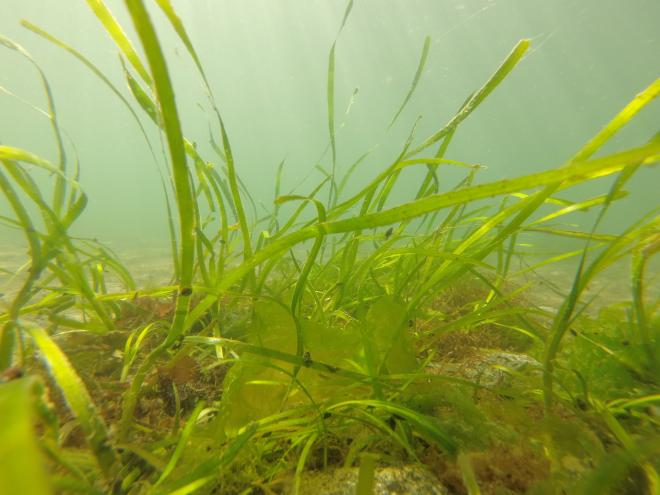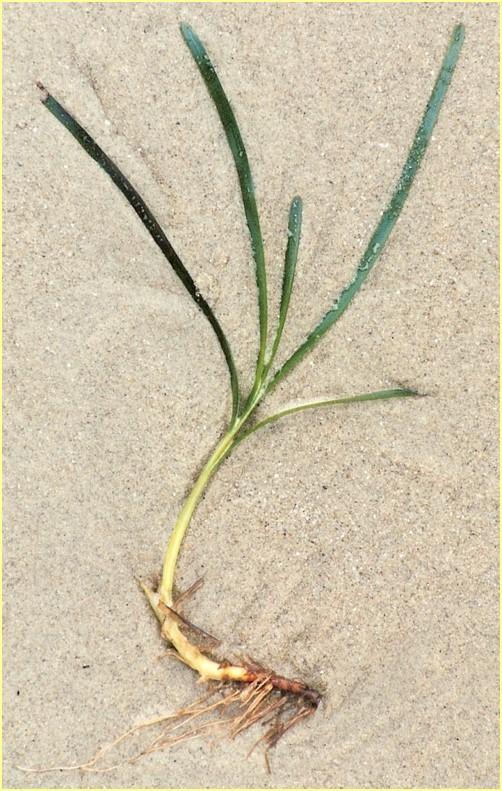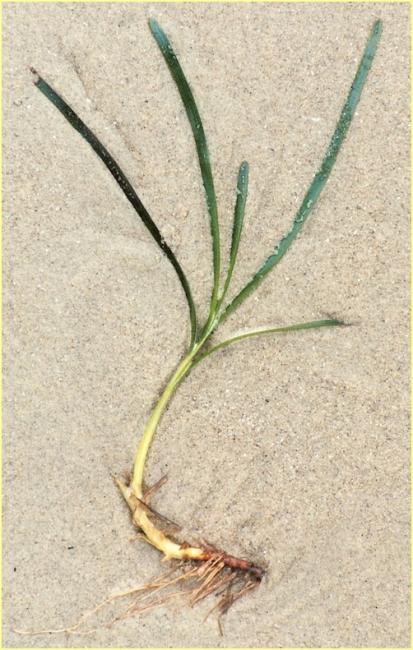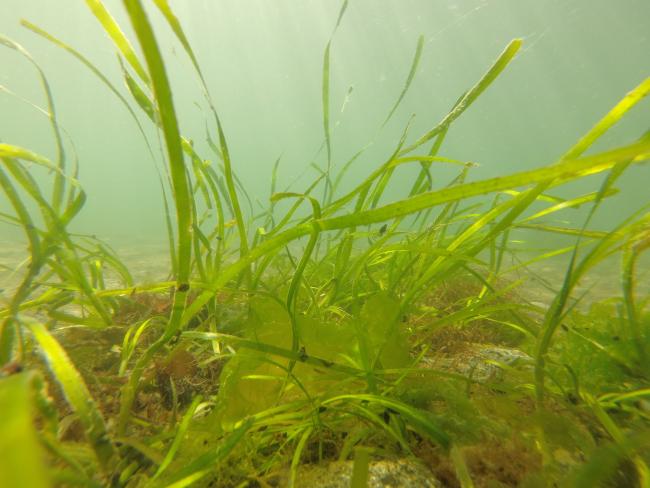
The Washington Department of Natural Resources is studying new ways of increasing ecologically important eelgrass habitat in Puget Sound. It is part of the state's effort to boost eelgrass 20% Sound-wide by 2020. So far, recovery of the species has fallen short of that goal, but transplanting efforts are showing promise.

Background
Eelgrass (Zostera marina) is an aquatic flowering plant found throughout much of the northern hemisphere. It grows in dense patches close to the shore, where it forms vital habitat for Chinook salmon and other species of the Salish Sea. The largest spindly leaves of some plants can grow to over three feet in length and nearly an inch wide, but the plant is also found in more modest sizes depending on the conditions. It can spread either by seed or through broad root systems that expand just under the surface of soft sediments near the intertidal zone.
Wherever they occur, eelgrass beds are important for many organisms. Pacific herring lay their eggs on the plant’s leaves. Young Chinook and other salmon use eelgrass beds as a nursery where they grow as they migrate from their freshwater spawning grounds out to sea. Adult salmon may not use eelgrass beds as directly as young ones do, but they are known to lurk about the edges, feeding on the fish within it.
In this sense, eelgrass does not just provide habitat and shelter, it is also central to the food web. (Imagine being able to eat your own home, scientists say.) Invertebrates that feed on the plant or cling to it, are devoured by juvenile salmon which are eaten by other fish or birds, or they survive to adulthood, and if they do, they might in turn become food for the southern resident killer whales, or humans. Absent eelgrass, all of those associations wither. “When there’s bare substrate, you just have a lot fewer species, a lot fewer invertebrates,” says Jeff Gaeckle, an ecologist with the Washington Department of Natural Resources (DNR). “It’s like the difference between a healthy forest and a desert.”
Last February, Gaeckle and his colleagues authored a report that described an extensive effort to turn what had been patches of bare substrate (“desert”) into healthy eelgrass beds. Although the exact historical extent of eelgrass coverage in Puget Sound is unknown, it is thought to be declining in general, and in 2011, the Puget Sound Partnership set an ambitious goal of increasing eelgrass area by 20% by 2020, from an eight-year baseline of 53,300 acres. This increase translated to more than 10,300 acres.
The study
It was to help meet this goal that Gaeckle’s project began in 2016. The first task was to identify sites that might support transplanted eelgrass. Previous work had shown that, worldwide, only two-thirds of restoration projects lead to the actual establishment of seagrass. To improve site selection, Gaeckle and his team relied on the modeling work of Ronald Thom and his colleagues, which combined hydrodynamic models with spatially explicit predictive habitat variables, as well as the known historical presence of eelgrass.

From the model outputs, twenty-one restoration sites were identified in southern Puget Sound: Delano Beach, Joemma Beach State Park, Taylor Bay, Penrose State Park, McDermott Point, Anderson Island, South Head, and Fudge Point. These were further parsed as 14 test-transplant sites with just a few, smaller eelgrass restoration plots, and seven large-scale sites that would support at a minimum over 2,000 square meters of restored eelgrass beds. Additionally, there were three sites from which eelgrass would be harvested for transplant: Cutts Island, Rocky Bay, and DuPont Wharf.
Harvest and transplant work began in 2016. From the donor areas, biologists harvested over 155,000 eelgrass shoots. These were then spread around the different transplant and large-scale sites in both 2016 and 2017. Water quality monitors, tracking temperature, alkalinity, pH, and photosynthetically active radiation (PAR) were installed to compare the new eelgrass beds with adjacent eelgrass-less sites. In addition to providing habitat, studies have shown that eelgrass has the potential to improve water quality, and also help trap carbon. “Leaf material either gets sloughed off and buried, or moved to another environment,” Gaeckle says. “From there it enters the system, as invertebrate tissue, or clam, or as part of oyster.”
Key results
Divers sampled eelgrass area and shoot density at the transplant sites starting in May 2018. Eelgrass was only present at two of the ten test-transplant sites, but at the large-scale sites, eelgrass had persisted at five of the six sites, and in some places in densities of well over 200 shoots per square meter. The most successful site was Joemma Beach State Park, where, at four sites, eelgrass shoot density ranged from 158 to 266 shoots per square meter in a 160 square-meter area. When the Joemma Beach sites were sampled later in August and again in September, however, the densities were far more variable, ranging from 39 to 1,347 shoots per square meter. And while eelgrass had not spread beyond the original transplant transects, there was evidence at one of the sites that the transplanted patches had merged to form a more continuous bed.
Water quality data from May through August 2018—the most comprehensive period available, owing to fouling and other technical issues — showed that average hourly pH was higher in eelgrass compared to neighboring bare areas, which showed the capacity of eelgrass beds to help combat the effects of ocean acidification. PAR results were also complicated by the sensors becoming fouled, but before that happened PAR was found to be suitable for eelgrass growth in the sites.

Overall, the eelgrass transplants at Joemma Beach State Park were the most successful, the four large-scale sites supporting in total more eelgrass shoots, at nearly 170,000, than was planned for transplant. At one site, the transplanted patches from 2016 had expanded enough to join into a single bed, although one constrained within the original transplant boundary. At the other three sites, eelgrass was found but the densities had decreased since the transplant. (Some of the variability may have been due to seasonal conditions, and also different transplant methods.) Failure of the other large-scale sites at Anderson Island may have been due to eelgrass being covered with green algae.
“Eelgrass restoration is actively taking place in Puget Sound, and that’s for the good of everyone,” Gaeckle says. “Joemma Beach really showed us the value of the restoration process and points a way forward from here.” The DNR’s transplanting and monitoring efforts will continue through at least 2019, as biologists further refine their transplant methods.
Time, Gaeckle says, is of the essence. According to the most recent estimate from 2013 through 2015, the eelgrass coverage area has increased by 5.7% over the original baseline. That's far below the 2020 goal — which is only a year away — of a 20% increase. Scientists also have their doubts about the 5.7% number, which is small enough to fall within the statistical range of uncertainty. That makes it tough to declare a turnaround in eelgrass abundance. But even slow progress is still progress, they say.



